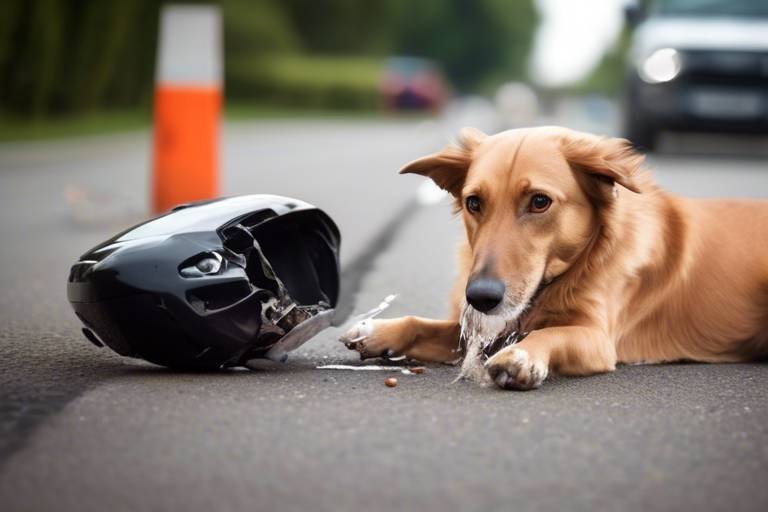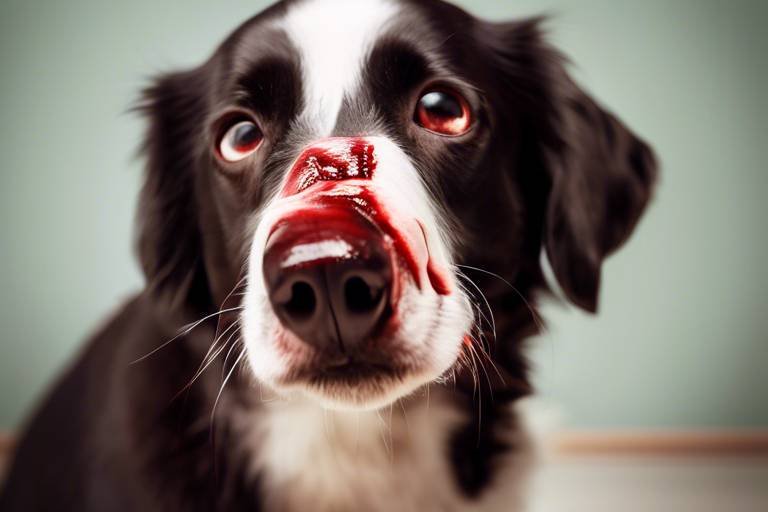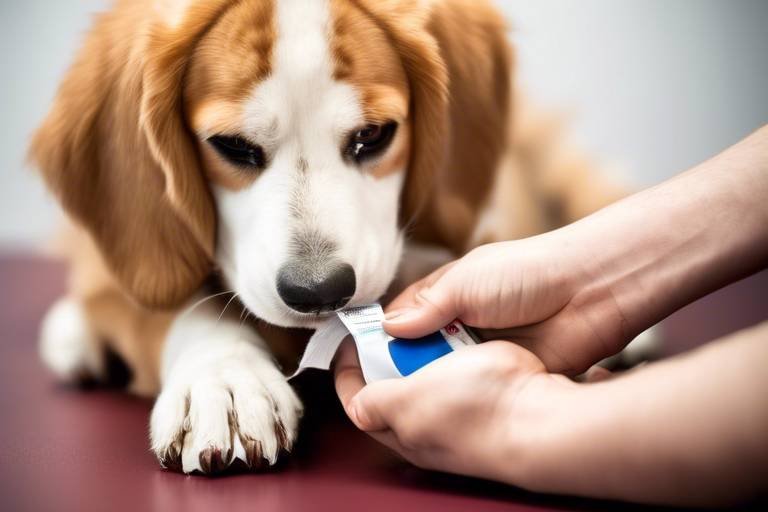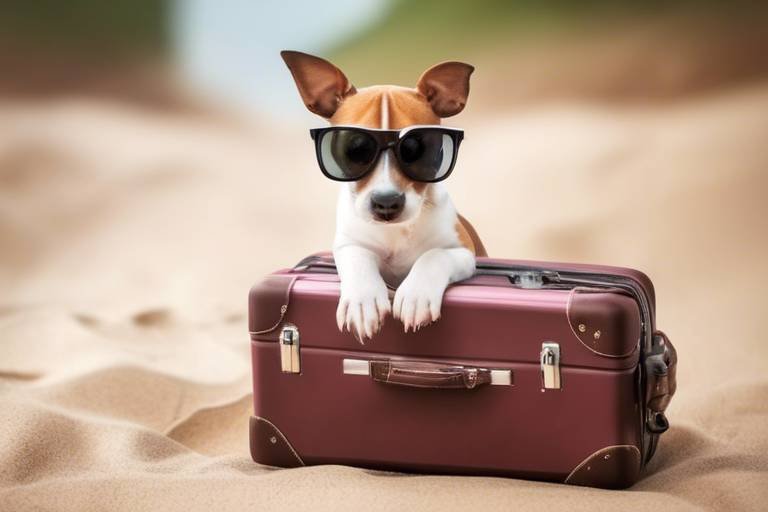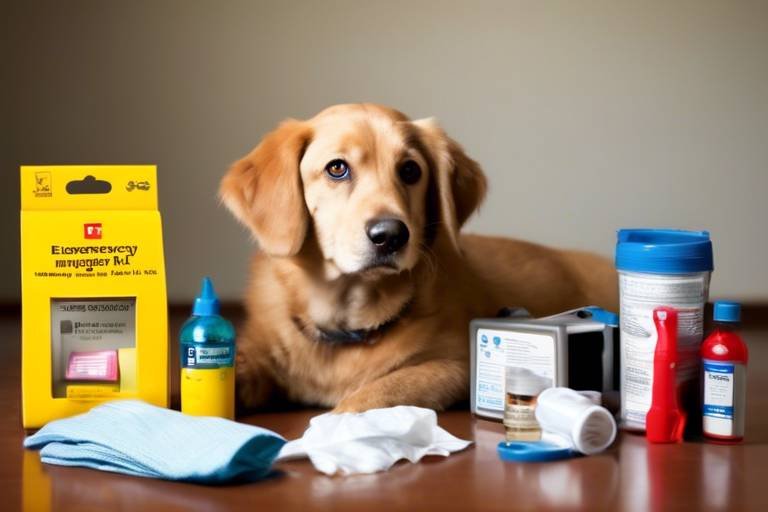How to Keep Your Pet Safe During Natural Disasters
Natural disasters can strike without warning, and as pet owners, we have a responsibility to ensure the safety and well-being of our furry companions during these challenging times. Imagine a hurricane bearing down on your home or an earthquake shaking the ground beneath your feet; your pets depend on you to keep them safe. This article provides essential tips and strategies for ensuring your pets are prepared, protected, and cared for during various natural disasters. Whether it's a wildfire, flood, or severe storm, being proactive can make all the difference.
Natural disasters come in many forms, each with its own set of challenges. From hurricanes and tornadoes to earthquakes and floods, the impact on pets can be severe and often devastating. Understanding the types of disasters that can affect your area is crucial for effective preparation. For instance, if you live in a region prone to flooding, having a plan that includes your pets is essential. The importance of being prepared for unexpected situations cannot be overstated; it’s not just about protecting your property, but also about safeguarding the lives of your beloved pets.
One of the most important steps in ensuring your pet's safety during a disaster is to prepare an emergency kit. This kit should be easily accessible and contain all the essentials your pet may need in a crisis. Think of it as a lifeline for your furry friend. Here’s what to include:
When preparing your pet's emergency kit, it's crucial to include sufficient food and water supplies. A good rule of thumb is to store at least a week's worth of food and water for each pet. Consider the following:
- Food: Choose non-perishable items or your pet's favorite dry food. Make sure to rotate supplies regularly to keep them fresh.
- Water: Store clean, fresh water in sturdy containers. Remember, pets need more water than you might expect, especially during stressful situations.
Having a pet first aid kit can be a lifesaver. It should include items such as bandages, antiseptic wipes, and any medications your pet may require. Knowing how to use these supplies effectively can make a significant difference in an emergency. Make sure to familiarize yourself with basic first aid techniques for pets, as this knowledge can help you respond quickly and efficiently if your pet gets injured.
Proper identification is vital during a disaster. Microchipping your pet is one of the best ways to ensure they can be returned to you if lost. Additionally, keep important documents such as vaccination records, medical history, and a recent photo of your pet in your emergency kit. This documentation can be crucial for boarding facilities or shelters that require proof of vaccinations.
In the event of a disaster, having a clear evacuation plan that includes your pets is essential. This plan should detail where you will go, how you will transport your pets, and what supplies you will take. Practice this plan with your pets so they become familiar with it. This preparation can help reduce anxiety and ensure a smoother evacuation process.
When a natural disaster strikes, immediate actions are necessary to keep your pets safe. Depending on the situation, you may need to shelter in place or evacuate. Staying calm and focused is crucial; your pets can pick up on your emotions, and a calm demeanor can help reassure them during chaotic times.
In the midst of a disaster, it’s easy to panic. However, remaining calm can help your pets feel more secure. Take deep breaths, speak softly to them, and reassure them that everything will be okay. This sense of security can reduce their anxiety and help them cope with the situation.
During a disaster, it’s important to keep an eye on your pet's behavior. Signs of stress or fear may include excessive barking, hiding, or destructive behavior. Recognizing these signs early can help you take steps to comfort and reassure them. Simple actions like petting them, providing their favorite toy, or creating a safe space can make a world of difference.
After the disaster has passed, the recovery process begins. It's essential to assess your pet's physical and emotional health. Just like humans, pets can experience trauma and stress, which can affect their well-being.
Check your pet for injuries or signs of distress after a disaster. Look for cuts, bruises, or unusual behavior. If you notice anything concerning, don’t hesitate to seek veterinary care. Remember, your pet's health is just as important as your own.
Pets can experience emotional fallout from disasters, just like us. They may exhibit anxiety or fear in the days and weeks following an event. To help them recover, provide a stable environment, maintain routines, and offer plenty of love and attention. Consider consulting with a veterinarian or animal behaviorist if your pet shows prolonged signs of distress.
Q: What should I do if I have to evacuate without my pet?
A: If you must evacuate, try to find a pet-friendly shelter or hotel. If that’s not possible, contact local animal shelters or rescue organizations for assistance.
Q: How can I help my pet feel more secure during a disaster?
A: Bring familiar items, such as their favorite blanket or toys, to provide comfort. Speak to them in a soothing voice and maintain a calm demeanor.
Q: How often should I update my pet’s emergency kit?
A: Review and update your emergency kit every six months to ensure that food, medications, and other supplies are fresh and up to date.

Understanding Natural Disasters
Natural disasters can strike without warning, leaving us scrambling to ensure the safety of our loved ones, including our furry friends. From hurricanes and earthquakes to floods and wildfires, each type of disaster presents unique challenges and risks. Understanding these disasters is the first step in preparing for them. For instance, hurricanes can lead to flooding, while wildfires can threaten homes and air quality. It's crucial to recognize how these events can impact not just us, but our pets as well.
When disaster strikes, the chaos can be overwhelming. Imagine your pet’s perspective: they may not understand why the ground is shaking or why the skies are darkening. This confusion can lead to anxiety and fear, making it essential to have a plan in place. Being prepared means knowing the specific risks in your area. For example:
- Hurricanes: High winds and flooding can endanger pets left outside.
- Earthquakes: Sudden movements can cause injuries to pets trapped under furniture.
- Floods: Rising water can isolate pets, making rescue impossible.
- Wildfires: Smoke inhalation and evacuations can pose serious risks.
Understanding these risks allows you to tailor your emergency plans to mitigate them effectively. For instance, if you live in a hurricane-prone area, you might want to invest in sturdy crates for your pets, ensuring they can be secured during a storm. On the other hand, if earthquakes are common, teaching your pets to go to a safe spot when they feel shaking can save their lives.
Moreover, being aware of the potential impact of natural disasters on pets is vital. Pets can suffer from physical injuries, but the emotional toll can be just as severe. Their routines get disrupted, and familiar environments become chaotic. This can lead to behavioral issues, stress, and anxiety. Therefore, preparation is not just about having supplies; it’s about creating a sense of security for your pets amidst the turmoil.
In conclusion, understanding natural disasters and their effects on pets is an integral part of keeping them safe. By being informed and proactive, you can ensure that your pets are not only protected but also feel secure during these unpredictable events. So, take the time to assess your local risks and make a plan that includes your furry companions. Remember, their safety is in your hands.

Preparing an Emergency Kit
When it comes to keeping your furry friends safe during a natural disaster, preparation is key. One of the most crucial steps is assembling a well-stocked emergency kit tailored specifically for your pets. Think of this kit as a lifeline—a treasure chest filled with everything your pet might need to weather the storm. But what exactly should you include in this kit? Let’s dive into the essentials!
First and foremost, you need to consider food and water supplies. Just like humans, pets require sustenance to stay healthy and energized. It's recommended to store at least a three-day supply of food and water for each pet. Opt for non-perishable items, such as canned food or dry kibble, and don't forget to rotate these supplies regularly to keep them fresh. You wouldn’t want your pet munching on stale food during a crisis, would you?
Now, let's talk about hydration. Water is vital, and pets can become dehydrated quickly, especially in stressful situations. Aim to have at least one gallon of water per pet per day. If you have multiple pets, you might want to consider a larger container or a portable water bowl. Keeping your pet hydrated can be the difference between a smooth recovery and a tough road ahead.
Next up, a pet first aid kit is an absolute must. This kit should include items like antiseptic wipes, gauze, adhesive tape, and any medications your pet might need. You can create your own kit or purchase a pre-made one designed for pets. Knowing how to use these supplies can make a world of difference in an emergency. For instance, if your pet gets a cut, being able to clean and bandage it properly can prevent infection.
Another vital aspect of your emergency kit is ensuring your pet has proper identification. Microchipping your pet is one of the best ways to ensure they can be returned to you if they get lost. Additionally, keep copies of important documents, such as vaccination records and your pet's medical history, in a waterproof bag. This way, if you need to evacuate, you can grab these documents quickly without scrambling through piles of paper.
Finally, don't forget about your pet's comfort items. Include their favorite toys, blankets, or anything that smells like home. Familiar scents can help soothe your pet during stressful times, acting like a security blanket in an uncertain world. By preparing an emergency kit with these essentials, you can ensure your pet's safety and well-being during a natural disaster.
In summary, assembling an emergency kit for your pets is not just a good idea—it's essential. Think of it as a way to show your love and commitment to their safety. You never know when disaster might strike, but with a well-prepared kit, you can face it head-on together!
Food and Water Supplies
When it comes to keeping your pets safe during a natural disaster, one of the most critical areas to focus on is their food and water supplies. Imagine being in a situation where you need to evacuate quickly, and you realize that you haven’t stocked up on enough supplies for your furry friends. The last thing you want is to add to your stress by worrying about their basic needs. So, let’s dive into what you should consider when preparing these essentials.
First and foremost, it’s essential to have a sufficient amount of food stored. Depending on the size and dietary needs of your pet, you should aim for at least a week’s worth of food. For example, if you have a medium-sized dog, consider storing around 15-20 pounds of dry kibble or canned food. It’s also wise to include some of their favorite treats to keep their spirits high during stressful times. If your pet has any special dietary requirements, make sure to account for those as well.
Water is just as crucial, if not more so. A general rule of thumb is to store at least one gallon of water per pet per day. This means for a week, you should have at least seven gallons of fresh water on hand. To keep this water fresh, consider using sealed containers that are easy to transport. Regularly check and rotate your supplies to ensure they remain safe for your pets to consume.
Additionally, think about how you will provide food and water during a disaster. If you need to evacuate, having portable food and water bowls can make a world of difference. You might also want to include a manual can opener if you’re storing canned food, as well as some plastic bags for waste disposal. These small details can help ease the transition for your pets, making them feel more comfortable amidst the chaos.
Lastly, consider creating a pet feeding schedule that you can stick to even during emergencies. This helps maintain some sense of normalcy for your pets. By planning ahead and ensuring you have enough food and water, you’re not just preparing for a disaster; you’re also showing your pets that you care about their well-being, no matter the circumstances. Remember, a well-prepared pet is a happy pet!
- How much food should I store for my pet? Aim for at least a week’s worth, depending on your pet's size and dietary needs.
- What type of water containers should I use? Use sealed, portable containers that are easy to transport and regularly check for freshness.
- Should I include treats in the emergency kit? Yes, including your pet's favorite treats can help keep their spirits up during stressful times.
- How can I maintain my pet’s feeding schedule during a disaster? Plan a feeding schedule ahead of time to maintain normalcy for your pets.
First Aid Essentials
When it comes to keeping your furry friends safe during a natural disaster, having a well-stocked pet first aid kit is absolutely crucial. Just like you wouldn’t head out on a road trip without your favorite snacks and emergency supplies, your pets deserve the same level of preparedness. Think of this kit as your pet’s safety net, ready to catch them in case of unexpected bumps along the way.
So, what should you include in this essential kit? First and foremost, you need to have basic medical supplies. This can include items like bandages, antiseptic wipes, gauze, and adhesive tape. These supplies can be lifesavers if your pet gets injured during a chaotic situation. It’s also wise to have a pair of scissors handy for cutting tape or gauze, as well as a digital thermometer to monitor their temperature if they seem unwell.
Next, don’t forget about any medications your pet may need. If your furry friend is on any prescription meds, be sure to have a sufficient supply to last at least a week. It’s also a good idea to include a copy of their prescriptions and any medical records in your kit. After all, you wouldn’t want to be scrambling to find this information when time is of the essence.
Additionally, consider adding a few comfort items to the kit. This might include a favorite toy or a blanket that smells like home. These items can provide a sense of security and comfort for your pet during stressful situations. Just like we find solace in familiar things, our pets do too!
Here’s a quick overview of what your pet first aid kit should ideally contain:
| Item | Description |
|---|---|
| Bandages | For wrapping wounds and preventing further injury. |
| Antiseptic Wipes | To clean wounds and prevent infection. |
| Gauze | For absorbing blood and covering wounds. |
| Adhesive Tape | To secure bandages in place. |
| Scissors | For cutting tape, gauze, or clothing if necessary. |
| Digital Thermometer | To monitor your pet’s temperature. |
| Prescription Medications | Any medications your pet needs regularly. |
| Comfort Items | A favorite toy or blanket to soothe your pet. |
Lastly, it’s essential to familiarize yourself with basic first aid techniques for pets. Knowing how to perform CPR on your pet or how to stop bleeding can make all the difference in an emergency. There are plenty of online resources and classes available that can teach you these vital skills. Just think of it as learning a new dance move; the more you practice, the more confident you’ll become!
In summary, a well-prepared pet first aid kit can be a game-changer during natural disasters. By equipping yourself with the right supplies and knowledge, you can ensure that your beloved pets receive the care they need when it matters most. Remember, being prepared isn’t just about having supplies; it’s about having peace of mind knowing you can handle whatever comes your way!
- What should I include in my pet first aid kit? Your kit should have bandages, antiseptic wipes, gauze, adhesive tape, scissors, a digital thermometer, prescription medications, and comfort items.
- How often should I check my pet first aid kit? It's a good idea to check your kit every few months to ensure that all supplies are up to date and in good condition.
- Can I use human medications for my pet? Never give your pet human medications without consulting a veterinarian, as some can be harmful or even fatal.
Identification and Documentation
When it comes to ensuring the safety of your pets during natural disasters, are crucial. Imagine being in a chaotic situation, and your furry friend gets scared and runs away. Without proper identification, the chances of reuniting with them diminish significantly. That’s why it’s essential to have a solid plan in place.
First off, consider microchipping your pets. This tiny chip, implanted just under their skin, contains vital information that can help reunite you with your pet if they get lost. It’s a one-time procedure that can make a world of difference. Just think of it as a safety net—small, discreet, and incredibly effective.
In addition to microchipping, ensure that your pets wear a collar with an ID tag. This tag should include your pet's name, your contact number, and any other relevant information. It’s like a little billboard advertising your pet’s identity! Make sure the collar is secure but comfortable, as pets can sometimes wriggle out of loose collars in a panic.
Now, let’s not forget about documentation. Keep a file with important records regarding your pets, including vaccination records, medical history, and proof of ownership. In the event of an emergency, having these documents readily available can save you a lot of time and hassle. You might even consider creating a digital copy stored in the cloud, so you can access it from anywhere, even if your home is inaccessible.
Here’s a quick overview of what to include in your pet’s identification and documentation:
- Microchip Information: Ensure it's registered with your contact details.
- ID Tags: Include your pet's name and your phone number.
- Vaccination Records: Keep them updated and easily accessible.
- Medical History: Document any previous illnesses or treatments.
- Proof of Ownership: This could be a receipt or adoption papers.
Lastly, consider creating a pet emergency plan that includes all this information. Store it in your emergency kit, so you have it on hand when you need it the most. Remember, when disaster strikes, being prepared can make all the difference in keeping your beloved pets safe and sound.
Q: How often should I update my pet's identification information?
A: It's a good idea to check and update your pet's identification information at least once a year, or whenever you change your contact details.
Q: What should I do if my pet goes missing during a disaster?
A: Immediately notify local shelters and veterinarians, and use social media to spread the word. The sooner you act, the better your chances of finding your pet.
Q: Is microchipping painful for pets?
A: The microchipping process is quick and generally causes minimal discomfort, similar to a routine vaccination.
Q: Can I get my pet microchipped at any vet?
A: Yes, most veterinary clinics offer microchipping services. You can also check with local animal shelters or rescue organizations.
Creating a Pet-Friendly Evacuation Plan
When disaster strikes, having a pet-friendly evacuation plan can be the difference between chaos and calm. Just like you wouldn’t leave your home without your wallet or keys, you shouldn’t leave your pets behind. An evacuation plan that includes your furry friends is essential for their safety and your peace of mind. So, how do you create one? Let’s dive into the details!
First things first, you need to identify safe locations where you can take your pets. This may include friends’ or family members’ homes, pet-friendly hotels, or emergency shelters that accommodate animals. It’s crucial to do your research ahead of time. Just imagine the stress of searching for a safe place while the winds are howling and the ground is shaking! Having a list of these locations prepared can save you time and heartache. You can even create a table like the one below to keep track of these options:
| Location | Contact Number | Pet Policy |
|---|---|---|
| Friend's House | (555) 123-4567 | Pets Allowed |
| Local Pet-Friendly Hotel | (555) 987-6543 | Pets Allowed, Extra Fee |
| Emergency Shelter | (555) 111-2222 | Pets Allowed |
Next, you’ll want to gather all the supplies you and your pets might need during an evacuation. Think about it: if you had to leave in a hurry, what would you grab? Here are some essentials to include in your evacuation kit:
- Food and Water: Pack enough food and water for at least three days. Don’t forget a travel bowl!
- Leashes and Carriers: Have leashes and carriers ready for each pet. This will help keep them secure and manageable.
- First Aid Kit: Include pet-specific first aid supplies, just in case.
- Comfort Items: Bring along their favorite toys or blankets to help soothe them.
Now, let’s talk about communication. Make sure that everyone in your household knows the evacuation plan. Practice it as a family, so it becomes second nature. You wouldn’t want to be frantically searching for your cat while your dog is barking at the door! Consider creating a map of your evacuation route that includes pet-friendly stops along the way. This can be a lifesaver during a stressful situation.
Finally, don’t forget about identification. Ensure that your pets have proper ID tags and, if possible, are microchipped. This is crucial in case you get separated during the chaos. You might also want to keep a copy of important documents, such as vaccination records and medical history, in your evacuation kit. These documents can be vital for your pet’s health and safety.
In conclusion, creating a pet-friendly evacuation plan is not just about having a strategy; it’s about ensuring your pets remain safe and secure during uncertain times. By preparing in advance, gathering necessary supplies, and practicing your plan, you can face natural disasters with confidence. Remember, your pets rely on you, so take the time to prepare!
Q: What should I do if I can't take my pet with me during an evacuation?
A: If you can't take your pet, try to find a safe place for them to stay, such as a pet boarding facility or a trusted friend’s house. Always leave them with plenty of food, water, and comfort items.
Q: How can I help my pet adjust after a disaster?
A: After a disaster, it’s important to provide emotional support to your pet. Spend time with them, maintain a routine, and consider consulting a veterinarian if you notice signs of distress.
Q: Should I have a separate emergency kit for my pet?
A: Yes, having a separate emergency kit for your pet is highly recommended. This ensures that you have everything you need for them readily available in case of an emergency.
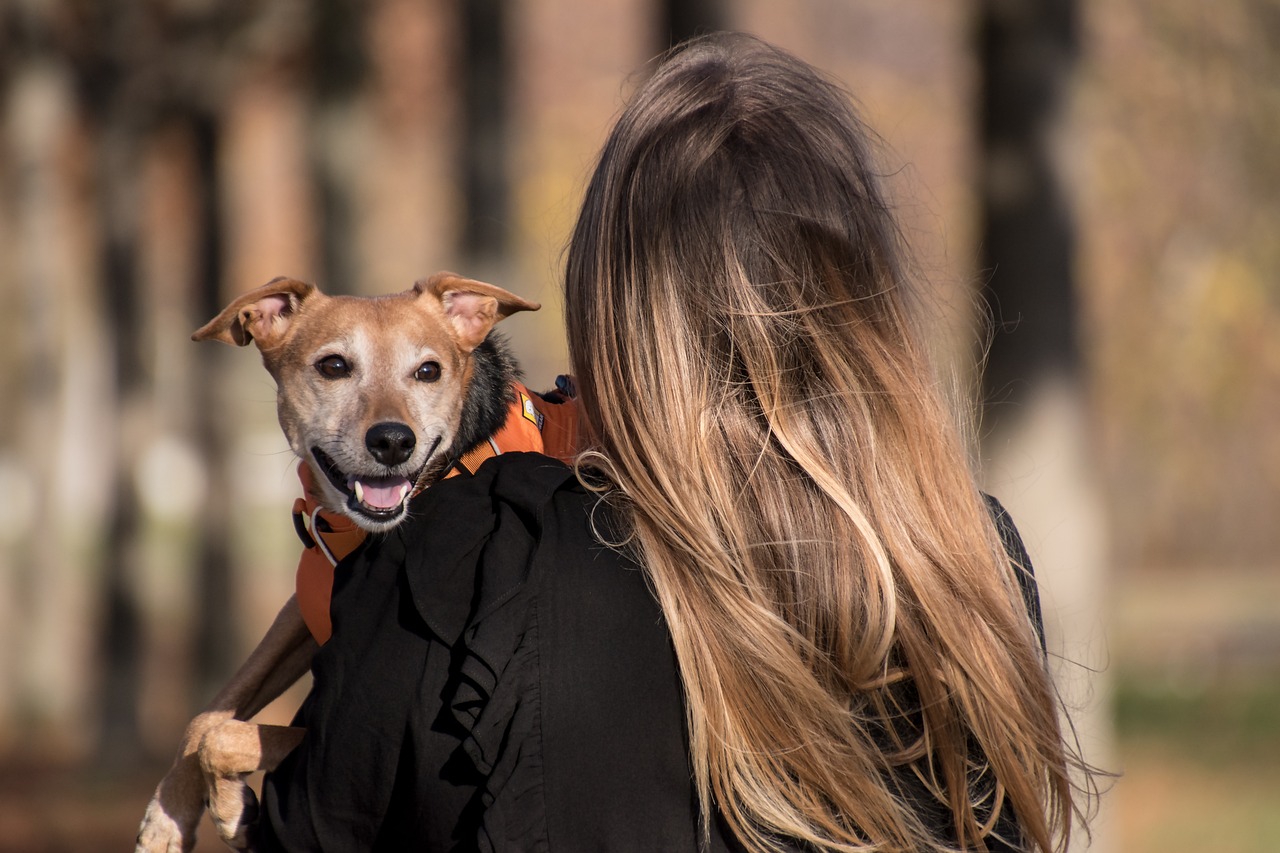
During a Natural Disaster
When a natural disaster strikes, the chaos can be overwhelming, not just for us but for our beloved pets as well. It’s crucial to have a plan in place to ensure their safety. Whether it’s a hurricane, earthquake, or wildfire, the immediate actions you take can make all the difference. Remember, your pets look to you for guidance, and your calm demeanor can significantly influence their behavior during these stressful times.
First and foremost, you need to assess your situation. If conditions allow, it’s often best to stay put and shelter in place. This means securing your home and creating a safe space for your pets. Close windows and doors, and turn off any sources of potential danger, like gas lines or electrical appliances that could cause fires. Create a cozy spot with their favorite blankets and toys to help them feel more at ease. The goal is to make them feel safe and protected amidst the storm.
However, there are times when evacuation is necessary. If local authorities recommend leaving, don’t hesitate. Your pets are family, and they deserve to be included in your evacuation plans. Always have a pet carrier ready, and make sure they are comfortable with it. Familiarize them with the carrier before a disaster strikes; think of it as their little safe haven. If you need to evacuate, keep your pets leashed or in carriers to prevent them from running off in panic.
During the disaster, it’s essential to stay calm and focused. Your pets can sense your emotions, and they may pick up on your anxiety. If you’re panicking, they will likely panic too. Take deep breaths, and speak to them in a soothing voice. You might be surprised at how much a little reassurance can help. Try to maintain a routine as much as possible; this can provide a sense of normalcy for both you and your pets.
It's also important to monitor your pet's behavior closely. Just like humans, pets can exhibit signs of stress, such as excessive barking, whining, or hiding. If you notice these signs, try to comfort them by petting them gently or speaking softly to them. Sometimes, distraction can work wonders—play with their favorite toy or give them a treat to help them relax. Remember, a little love and attention can go a long way in soothing their nerves.
In the midst of the chaos, don't forget to keep an eye on their physical needs. Make sure they have access to fresh water and food, even if they seem too stressed to eat. Keeping their routine as normal as possible can help them feel secure. If you have multiple pets, try to keep them together if it’s safe to do so, as they can provide comfort to one another.
After the disaster has passed, it’s essential to assess the situation. Check your home for any hazards that could affect your pets, such as broken glass or fallen debris. If you had to evacuate, ensure your pets are safe and sound before you start cleaning up. Your pets will likely need some time to adjust back to normal life, so be patient and give them the support they need.
Q: Should I leave my pets behind if I need to evacuate?
A: Absolutely not! Always take your pets with you if you need to evacuate. They are part of your family and should be included in your emergency plans.
Q: How can I help my pet cope with stress during a disaster?
A: Keeping a calm demeanor, providing comfort items, and maintaining a routine can help your pet cope with stress. Engage them with toys or treats to distract them from the chaos.
Q: What if my pet gets lost during a disaster?
A: Ensure your pet is microchipped and has a collar with an ID tag. If they do get lost, contact local shelters and use social media to spread the word.
Staying Calm and Focused
When disaster strikes, it can feel like the world is spinning out of control, and your first instinct might be to panic. However, is crucial, not just for your own peace of mind but also for the well-being of your beloved pets. Animals are incredibly perceptive and can pick up on their owner's emotions. If you're frazzled, your pets will likely become anxious, which can escalate the situation further. So, how do you maintain that calm amidst the chaos?
First, take a deep breath. It may sound cliché, but deep breathing is an effective way to reduce stress. Inhale slowly through your nose, hold for a moment, and then exhale through your mouth. Repeat this a few times until you feel your heart rate begin to steady. This simple act not only calms you but also sends a reassuring vibe to your pets. Think of it as a calming ripple effect—your tranquility can help soothe their nerves.
Next, create a safe space for your pets. This could be a designated area in your home where they feel secure, filled with their favorite toys, blankets, and even your worn clothing. Familiar scents can provide comfort and help them feel more at ease. If you need to evacuate, having a travel crate ready can also serve as a comforting shelter for them during the chaos of leaving home. Remember, this space should be easily accessible, so you can quickly guide your pets there when the time comes.
During the disaster, it’s essential to keep your pets engaged to distract them from the noise and commotion. Bring out their favorite toys or engage in simple games. This not only keeps their minds occupied but also reinforces the bond you share. Consider the following activities:
- Interactive toys: Puzzle toys can keep them busy while providing mental stimulation.
- Gentle play: Engage in low-energy games that won’t add to their stress.
- Training exercises: Simple commands can help redirect their focus and reinforce positive behavior.
Lastly, have a plan for communication. If you’re with others during a disaster, establish a way to communicate about your pets. This could mean designating someone to keep an eye on them while you handle other matters or using a whistle or specific call that they recognize. This ensures that everyone is on the same page and can help keep your pets safe and calm.
In summary, staying calm and focused during a natural disaster is not just about maintaining your own composure; it’s about creating a sense of security for your pets. By breathing deeply, establishing a safe space, engaging them in activities, and communicating effectively, you can help both yourself and your furry friends navigate through the storm with a little more ease.
- What should I do if my pet becomes anxious during a disaster? It's essential to comfort them with your presence, use calming techniques such as deep breathing, and engage them in comforting activities.
- How can I prepare my pet for a possible evacuation? Create a travel kit that includes food, water, medications, and a familiar blanket or toy to help them feel secure.
- Are there specific signs of stress I should look for in my pets? Yes, watch for behaviors such as excessive barking, hiding, or destructive actions, which can indicate anxiety.
Monitoring Your Pet’s Behavior
When disaster strikes, our beloved pets can experience a whirlwind of emotions, much like we do. It's crucial to monitor your pet's behavior during these stressful times to ensure their safety and well-being. Just like humans, pets can show signs of stress or fear, and being aware of these signs can help you take action to comfort them. Have you ever noticed your dog trembling or your cat hiding under the bed during a storm? These behaviors are their way of expressing anxiety, and recognizing them is the first step in providing the support they need.
One of the most common signs of stress in pets is excessive barking or meowing. If your furry friend is vocalizing more than usual, it's a good indicator that they're feeling uneasy. Additionally, watch for physical signs such as panting, pacing, or drooling. These behaviors can indicate that your pet is in distress. If you notice these signs, try to create a calming environment. Soft music, dim lighting, or even a cozy blanket can help soothe their nerves.
Another behavior to keep an eye on is changes in appetite. Some pets may refuse to eat, while others might overindulge as a coping mechanism. It's essential to offer their favorite foods but also to ensure they’re eating a balanced diet. If your pet isn't eating for an extended period, consider consulting your veterinarian.
During a disaster, your pet might also seek out your presence more than usual. They may follow you around the house or try to stay close to you. This behavior is their way of seeking comfort and reassurance. Make sure to provide them with plenty of affection and attention, as this can significantly help reduce their anxiety. You can also create a safe space for them, a spot where they can retreat to feel secure. This could be a designated room or a cozy corner with their favorite toys and bedding.
It’s also important to remember that every pet is unique. Some may respond to stress with aggression, while others may become withdrawn. Keep an eye out for these behavioral changes and be prepared to act accordingly. If your pet seems overly aggressive or defensive, it might be best to give them space until they calm down. On the other hand, if they’re withdrawn, gentle encouragement and playtime can help bring them back to their usual selves.
In summary, monitoring your pet's behavior during a natural disaster is crucial. By being aware of their signs of stress, you can take proactive steps to comfort them and help them cope. Remember, your calm demeanor can also influence how they feel; if you stay composed, they’re more likely to feel secure. So, keep an eye on those furry friends, and don’t hesitate to reach out to a vet if you’re concerned about their well-being.
- What are the signs of stress in pets during a disaster?
Common signs include excessive barking, panting, drooling, changes in appetite, and seeking closeness to their owners. - How can I calm my pet during a disaster?
Creating a safe space, using calming music, and providing affection are effective ways to help soothe your pet. - Should I consult a vet if my pet is showing signs of distress?
Yes, if your pet's behavior changes significantly or they refuse to eat for an extended period, it's best to consult a veterinarian.

Post-Disaster Recovery
After the chaos of a natural disaster, the recovery process is crucial—not just for us, but for our beloved pets too. Just like us, pets can experience stress, anxiety, and even physical injuries after such traumatic events. It's essential to prioritize their health and emotional well-being to help them bounce back. So, what steps can you take to ensure your furry friends are on the road to recovery?
First and foremost, assessing your pet's physical health is vital. After a disaster, it’s common for pets to hide injuries or distress. Take some time to thoroughly examine your pet for any visible signs of injury, such as limping, cuts, or unusual behavior. If you notice anything out of the ordinary, don’t hesitate to reach out to your veterinarian. Even if your pet seems fine, a check-up can be a good idea to rule out any hidden issues. Here’s a quick checklist of things to look for:
- Visible injuries or wounds
- Changes in appetite or drinking habits
- Behavioral changes, such as increased aggression or withdrawal
- Signs of stress, like excessive barking or hiding
Next, let’s talk about the emotional well-being of your pets. They might not express their feelings the way we do, but they can definitely feel the effects of a disaster. Just like how we might feel anxious or unsettled after a traumatic experience, our pets can too. To help them regain their sense of security, consider creating a safe space in your home where they can retreat when feeling overwhelmed. This could be a cozy corner with their favorite blanket or a quiet room where they can relax away from the noise of recovery efforts.
Moreover, routine is everything! Animals thrive on consistency, so try to maintain their regular feeding, walking, and playtime schedules as much as possible. Engaging them in familiar activities can significantly help in restoring their confidence and calmness. If your pet enjoys certain toys or games, bring those out to help distract them from the stress of the situation.
In addition to physical and emotional recovery, don’t forget that social interaction is key. If your pet is used to being around other animals or people, try to reintroduce them to their social circle gradually. This could mean inviting friends over or arranging playdates with other pets. Just be sure to monitor your pet’s reactions and give them space if they seem overwhelmed.
Lastly, keep an eye on your pet for any long-term behavioral changes. Some pets may develop fears or anxieties related to specific sounds or situations that remind them of the disaster. If you notice persistent issues, consider consulting a professional animal behaviorist or a veterinarian who specializes in pet psychology. They can provide strategies and support to help your pet cope with their fears.
Q: How can I tell if my pet is stressed after a disaster?
A: Signs of stress in pets may include excessive barking, hiding, changes in appetite, or destructive behavior. Pay close attention to any changes in their normal behavior.
Q: Should I take my pet to the vet even if they seem fine?
A: Yes, it’s a good idea to have a vet check-up after a disaster to ensure there are no hidden injuries or health concerns.
Q: How can I help my pet regain their confidence?
A: Maintain a routine, provide a safe space, engage in familiar activities, and gradually reintroduce them to social settings.
Q: What if my pet develops a fear of loud noises after a disaster?
A: Consult a veterinarian or an animal behaviorist for strategies to help your pet cope with their fear.
Assessing Physical Health
After a natural disaster strikes, your first instinct might be to check on your loved ones, but let's not forget about our furry companions! Assessing your pet's physical health is crucial for their recovery and well-being. Just like us, pets can experience injuries, stress, and even illness after a traumatic event. So, how do you go about ensuring your pet is in tip-top shape?
First things first, conduct a thorough visual inspection. Look for any obvious signs of injury, such as limping, swelling, or bleeding. Pay attention to their eyes, ears, and mouth. Sometimes, pets can hide their pain really well, so you might need to be a bit of a detective. If you notice anything unusual, it’s best to consult your veterinarian. Remember, even minor injuries can lead to bigger problems if left untreated!
Next, consider the emotional toll that disasters can take on animals. Just like humans, pets can suffer from anxiety and stress after a crisis. Watch for behavioral changes: Is your usually playful dog now hiding under the bed? Or is your cat unusually aggressive? These could be signs that your pet needs some extra love and reassurance. Creating a calm environment can help them feel secure and safe.
In addition to visual checks, it’s important to monitor their eating and drinking habits. After a disaster, pets may refuse to eat or drink due to stress. Ensure they have access to fresh water and their favorite food. If they continue to avoid food for more than a day, it’s advisable to reach out to a vet. A healthy appetite is a good indicator of a healthy pet!
Here’s a quick checklist to help you assess your pet’s physical health post-disaster:
- Check for visible injuries (cuts, bruises, limping).
- Monitor eating and drinking habits.
- Observe behavior for signs of stress or anxiety.
- Look for any unusual symptoms (vomiting, lethargy).
- Consult a vet if any concerning signs appear.
Lastly, don’t forget about their vaccination status. After a disaster, pets can be exposed to various diseases, especially if they were in contact with other animals or contaminated water. Make sure their vaccinations are up to date and discuss any necessary boosters with your veterinarian.
In summary, taking the time to assess your pet's physical health after a natural disaster is essential. By being observant and proactive, you can ensure that your furry friend recovers quickly and returns to their happy, playful self. Remember, a healthy pet is a happy pet!
- What should I do if my pet is injured after a disaster?
Contact your veterinarian immediately for advice and treatment options. If the injury is severe, seek emergency veterinary care. - How can I help my pet cope with stress after a disaster?
Create a calm environment, provide comfort items (like their favorite blanket), and spend quality time with them to help them feel secure. - When should I take my pet to the vet after a disaster?
If you notice any signs of injury, illness, or behavioral changes that concern you, it's best to consult your veterinarian as soon as possible.
Emotional Well-being
After a natural disaster, the emotional well-being of your pets is just as crucial as their physical health. Pets, much like humans, can experience stress, anxiety, and even trauma from such events. Imagine how disorienting it must be for them to witness their environment change dramatically, perhaps losing their home or being separated from their familiar surroundings. It's essential to recognize that our furry friends rely on us for comfort and reassurance during these challenging times.
One of the first steps you can take to support your pet's emotional recovery is to establish a routine. Animals thrive on predictability, and after the chaos of a disaster, they may feel more secure if you can provide them with a sense of normalcy. This includes regular feeding times, walks, and play sessions. Try to maintain their usual schedule as much as possible, as it helps them feel grounded and safe.
Additionally, creating a safe space for your pet is vital. This could be a quiet room or a cozy corner with their favorite blanket and toys. A familiar environment can help reduce anxiety and provide a retreat where they can feel secure. You might also consider using calming products, such as pheromone diffusers or anxiety wraps, which can help soothe their nerves.
It's also important to pay attention to your pet's behavior. Look for signs of distress, such as excessive barking, hiding, or changes in appetite. If you notice these signs, try to engage them in gentle play or offer treats to encourage positive behavior. Sometimes, simply being present can make a world of difference. Spend time cuddling, petting, or just sitting quietly with your pet to help them feel more at ease.
If your pet continues to show signs of anxiety or distress, it might be beneficial to consult with a veterinarian or a pet behaviorist. They can provide additional strategies tailored to your pet's specific needs. Remember, just like us, our pets may need a little extra help to bounce back after a traumatic experience.
In conclusion, the emotional well-being of your pets should never be overlooked in the aftermath of a disaster. By offering a stable routine, creating a safe space, and being attentive to their emotional needs, you can help your beloved companions regain their confidence and happiness. After all, they rely on us to be their advocates and protectors, especially during tough times.
- How can I tell if my pet is experiencing stress after a disaster? Look for signs such as excessive barking, hiding, changes in appetite, or destructive behavior.
- What should I do if my pet refuses to eat after a disaster? It's not uncommon for pets to lose their appetite during stressful times. Try offering their favorite treats or wet food, and consult a vet if it persists.
- Are there specific products that can help calm my pet during stressful situations? Yes, products such as pheromone diffusers, calming collars, and anxiety wraps can be effective in reducing stress.
- When should I seek professional help for my pet's emotional issues? If your pet's anxiety or stress continues for an extended period or worsens, it's best to consult with a veterinarian or a pet behaviorist.
Frequently Asked Questions
- What types of natural disasters should I be prepared for with my pets?
It's crucial to consider various natural disasters such as hurricanes, earthquakes, floods, and wildfires. Each type poses unique challenges and risks for your pets, so understanding the specific threats in your area helps you prepare more effectively.
- What should I include in a pet emergency kit?
Your pet emergency kit should include essentials like food and water supplies, a first aid kit, medications, leashes, collars, and identification documents. Don’t forget comfort items like toys or blankets to help soothe your pet during stressful times!
- How much food and water should I store for my pet?
A good rule of thumb is to have at least a 3-day supply of food and water for each pet. This ensures they have enough to eat and drink, especially if you can't access stores immediately after a disaster.
- Is microchipping my pet really necessary?
Absolutely! Microchipping is a vital step in ensuring your pet can be identified if they get lost during a disaster. It’s a permanent form of identification that significantly increases the chances of being reunited with your furry friend.
- What should I do if I have to evacuate with my pets?
Plan ahead by creating a pet-friendly evacuation plan. Ensure your pets are familiar with their carriers or leashes, and have your emergency kit ready to go. Always choose a pet-friendly shelter or hotel when evacuating.
- How can I help my pet stay calm during a disaster?
Staying calm yourself is key! Pets can sense your anxiety, so try to maintain a soothing presence. Use comforting words, provide treats, and keep them close to you to help them feel secure during stressful situations.
- What signs should I look for to assess my pet's emotional well-being after a disaster?
Watch for changes in behavior such as excessive barking, hiding, or aggression. If your pet seems withdrawn or anxious, they may need extra love and reassurance to help them recover from the trauma of the disaster.
- When should I take my pet to the vet after a disaster?
If you notice any injuries or signs of distress, such as limping, vomiting, or unusual behavior, it’s best to consult your veterinarian. They can provide necessary care and check for any hidden injuries that may not be immediately apparent.








